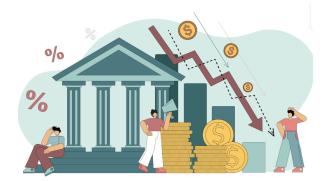
This is not a 2008 financial meltdown, at least not yet..
Lots of market updates this week but let’s start with this interesting, published research. Where a tested, established and repeated insight that said individuals/families' measurement of happiness with income top out at about $75,000 adjusted for inflation. The marginal utility of earnings over that figure does not result in an increase in happiness.
The Study performed in 2010 and an opposing hypothesis that more income does increase happiness. Turns out for the majority of individuals and family's happiness does increase with higher income. To learn more about this study here is a link:
Does more money correlate with greater happiness? | Penn Today
On to our market commentary. Bank failures and a credit crisis emerged as the tide of interest rates receded. Turns out the emperor has no clothes. The Federal Reserve has been increasing interest rates at breakneck speed in order to slow the economy and slow down inflation. It takes a while for higher interest to impact the economy, but one unintended consequence of this increase, is in the banking sector.
Only the largest banks are subject to periodic stress tests which measure how the banks would react to various adverse economic events. These banks are the largest. Often called money center banks. The next tier of banks, the regional banks, are not subject to these stress tests from the bank regulators but are subject to the stresses of monetary policy such as interest rate increases.
Banks fail every year and FDIC insurance covers most deposits at smaller banks but turns out certain banks have a large percentage of deposits that are uninsured that are at risk for being withdrawn at any sign of bank distress. Banks are subject to reporting requirements, and it turns out that some banks carried their investments on their balance sheet at book value or the value at purchase.
The fair market value of those securities has declined as interest rates increase-assets for banks include mostly bonds and real estate-both have fair market value impacted negatively as interest rates rise. When information is distributed- think: social media/twitter, deposits start to be withdrawn. In order to meet these demands banks, have to sell assets. Assets carried at book value mean nothing because when they are sold it is for fair market value subsequently creating a loss. Fear takes over and depositors run for the exit and then the FDIC steps in.
The question is what happens to uninsured deposits? The Federal government stepped in and insured all deposits at the three failed banks by creating a fund that lends the banks money based on the security of the long-term bonds in their investment portfolio. The bonds they own are high quality government backed mortgage securities, US Treasury and long-term high quality municipal bonds. If held to maturity, these bonds will pay their face value.
Ironically, as this bank crisis emerged, bond prices rallied in the space of a day and then week at historically high rates meaning interest rates have fallen and fair value bond prices have increased.
Meantime, the stock market declined based on this limited credit crisis. This is not a 2008 financial meltdown, at least not yet and it is unlikely that this is a repeat of 2008/9. The financial/banking system is stronger due to reforms implemented after 2008/9. Paradoxically, this crisis will slow down the economy and force asset values to decrease. What will the Federal Reserve do next week at its meeting? This is the big question. Markets betting on Fed moves have been whipsawed the last week with bets on a 1/2% increase high based on inflation and employment data and then this week decline to a bet on no increase or ¼% because of the bank failures. We will have to wait and see.
Weekly Catch-Up - News Articles That Caught Our Eye
- Is My Money Safe After the SVB Collapse? How Banks Protect Your Money. - The New York Times (nytimes.com)
- https://www.fdic.gov/resources/deposit-insurance/
- How to Set Boundaries With a Difficult Family Member - The New York Times (nytimes.com)
This website is informational only and does not constitute investment advice or a solicitation. Investments and investment strategies recommended in this blog may not be suitable for all investors. SAS Financial Advisors, LLC and its members may hold positions in the securities mentioned within this newsletter. SAS Financial Advisors, LLC is not responsible for any third-party content referenced.
The SAS Newsletters are posted on the SAS Blog weekly: https://www.sasadvisors.com/blog.

